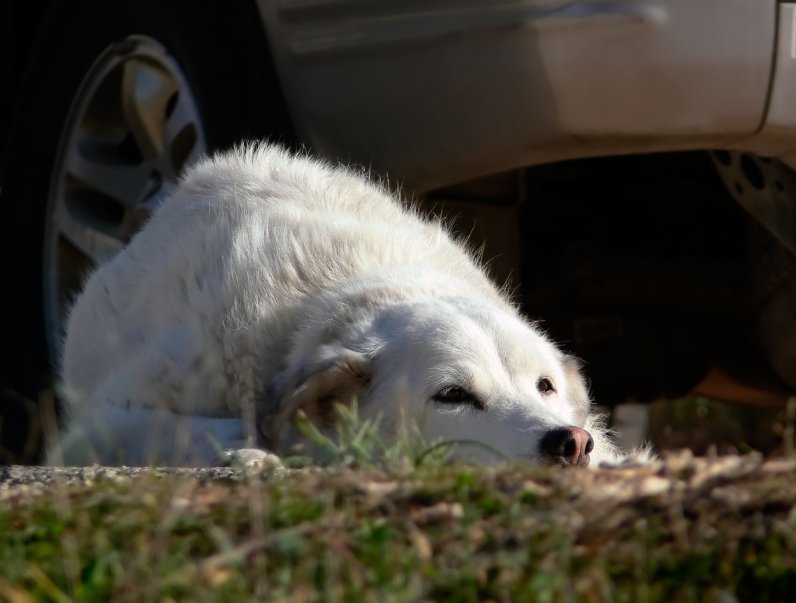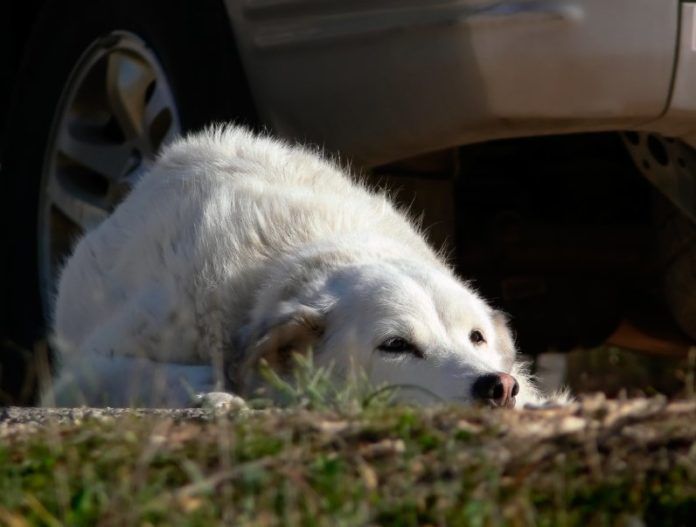If your dog is afraid to get in the car, it’s easy to leave her home when you go grocery shopping or drive to the post office. But what about, say, an hour-long ride to a friend’s house where you’ll be staying all day if you don’t want to leave your dog home alone for so many hours? Or an overnight several hours away?
What If Your Dog Needs to Go on a Multi-Night-Long Trip?
Travel anxiety in dogs puts their owners in a conundrum — include their canine family member in their driving plans or leave them home all day, or, if it’s going to be many days, in a kennel? None of these options is stress-free, either for the anxious dog or her human family. And with more and more opportunities these days for dogs to accompany their human families to hotels and other places — a good thing on the surface — for those whose dogs hate the car, it presents more and more opportunities for difficult decisions. Fortunately, no matter how extreme your dog’s anxiety in the car, there are ways to ease your pet toward a comfortable and enjoyable travel experience.
Help Your Dog Adjust to the Car Gradually
“For treating a genuine fear of travel, the gold standard is systematic desensitization to the car, but you have to start from where your dog is,” says Stephanie Borns-Weil, DVM, who treats patients at Tufts’s Animal Behavior Clinic.

Istock
If you have a young puppy without any “baggage,” you need only take her on rides to, say, a fast food drive-through for a delectable treat so that she makes positive associations with getting in the car. But for an older adopted dog who has come to associate car rides with being surrendered to the kennel or visiting the vet, you may need to devote months to systematic desensitization.
That could involve starting not inside the car but somewhere in its vicinity. You may need to play with your dog, sweet talk her, or offer treats within sight of the vehicle, slowly setting the stage for her to let her guard down about the car in general. Once you can get your dog near the car, you can begin putting treats on the car floor for her to reach, then accustom her to sitting in the car and later still, becoming comfortable with you starting the motor. As you progress, you should continue feeding your dog delicious treats to counter-condition her to associate the car with something pleasant.
“Sometimes you can get out of the car with your dog and then go back in again,” Dr. Borns-Weil says, “keeping in mind that you don’t want to do desensitization in a linear way because your dog will think that her situation will only get worse if she accepts a car-connected treat. It’s a good idea to back up sometimes, so to speak, and only have your dog approach the car for a goodie even though you’ve already gotten her used to sitting in the car.”
There are dogs who take to this method relatively quickly, within weeks rather than months. Some dogs also throw curve balls. They have no problem getting in the car and riding around but become noticeably distressed depending on which direction you turn. Dr. Borns-Weil recalls one dog who was fine with a car ride, provided that at the end of the block, the owner turned right, which the dog knew was in the direction of the dog park. If the owner turned left, in the direction of the veterinarian’s office, the dog started panting nervously. Fortunately, in that case, the issue was remedied quickly with a few treats provided while the owner drove in the direction of the veterinarian’s office without actually visiting the office. For a less resilient dog, the desensitization time could be significantly longer.
Whatever the situation, “you have to stay in the comfort zone of the dog and increase that comfort zone gradually,” no more quickly than the dog can bear without becoming upset, says Dr. Borns-Weil. Certainly, you should never attempt to fix the situation in one try by “flooding” your dog with a forced car ride that you believe will get her over her fear. Though you might anticipate that this will demonstrate to your dog that nothing terrible happens during drives, such an action doesn’t take into consideration that a forced ride is a trauma in itself, one that can only clinch her understanding of car rides as frightening experiences. Your dog’s travel anxiety is always best considered from her perspective.
If you’re short on time before the designated travel day:
For people with a dog who suffers from significant travel anxiety but who want to take her along for a trip somewhere before they have had lots of lead time to devote to systematic desensitization, there are some step-saving possibilities. One involves the crate. Provided your dog takes comfort in her crate, she can be carried into the car with a blanket over her crate. That might allow her to feel safe in what would otherwise be a series of anxiety-provoking, car-approaching events. A scared dog might even prefer staying covered as the car goes along. The movement of the vehicle could prove less overwhelming.
Thundershirts, which are calming vests that apply just the right amount of pressure to make your dog feel more secure (think swaddling), have also been shown to lessen anxious responses in some dogs. Also useful is a calming cap, which Dr. Borns-Weil equates with a fly mask for horses because it limits how much visual stimulation your dog receives. Made of thin spandex, the calming cap fits over the head and eyes of the dog, allowing in enough light and vision to walk about and even play, but diminishing how much light and movement she takes in.
Both the Thundershirt and the calming cap “can be especially helpful for dogs that are not anxious about driving but reactive in the car — what they can’t see, they can’t react to,” says Dr. Borns-Weil. Sometimes that’s a dog on the street about whom a dog in a car might feel territorial. Sometimes it’s a sensory overload of light and motion.
Alternative remedies might be another option for enhancing desensitization. For instance, while Dr. Borns-Weil says she hasn’t yet seen any evidence of the efficacy of homeopathic treatment for travel anxiety, she does believe that some herbal treatments can be helpful. “I’m not an expert on herbs but some of them, such as chamomile and lavender for relaxing and valerian for sedating, do have active ingredients in them that could be beneficial, though not enough to manage true car anxiety.” In other words, they might prove useful as adjunctive therapies to move the desensitization along a little more smoothly.
On the other end of the spectrum are those who take their dogs on long car rides but choose to spare them the entire experience by tranquilizing them to the point of knocking them out. It’s a solution Dr. Borns-Weil does not find beneficial in most cases. “It’s best to get rid of the anxiety but keep the dog there,” that is, conscious.
Medications for Travel-Anxious Dogs
Sometimes medications, including anti-anxiety drugs, can be of help with the desensitization program, especially if a dog simply can’t be calmed no matter how patiently you try to desensitize her, and no matter for how long you try. One of Dr. Borns-Weil’s patients was able to help her dog with clonidine, used to treat fear-based issues such as phobias. The clonidine calmed her enough to manage car rides cross-country. Another dog was successfully administered buspirone, which has a tranquilizing effect.
Short-term use of medication helps dogs not feel traumatized further and also allows those who are especially anxious to tolerate the process of desensitization better, says Dr. Borns-Weil.
Unplanned Car Trips
For dog owners who have to go away and haven’t had time to prepare their dog with any aspect of the desensitization process, it may be preferable to keep their pet at home with a sitter or place her in a kennel rather than attempt to make her endure a long trip. It’s like making her go to the moon when she hasn’t even gotten the hang of driving across town. That doesn’t take desensitization off the table for the future. It just means devoting the necessary time to it when the time is there to be had.






Dog is two years old, a rescue, and hates the car. Very anxious, drools uncontrollably and vomits. I’ve tried short rides and treat trips to no avail. Her stomach gets so upset, she won’t take a treat to get in the car. HELP? I so wanted her to enjoy taking rides with us. She has never been crated and had a rough start in life so she is not easily trusting.